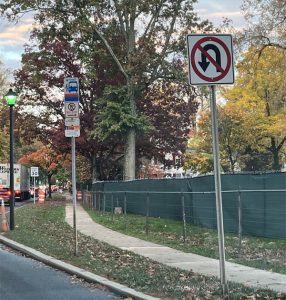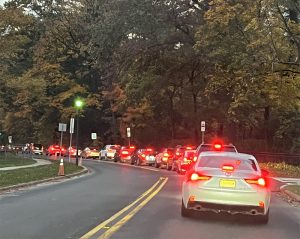 You’ve likely seen construction taking place around Princeton. What is being added? What is to come? A new hotel and changes to roadways are all in the works. But there is also construction underway and planned for apartment buildings and other housing in several areas of town, set to include affordable housing units the town needs to build.
You’ve likely seen construction taking place around Princeton. What is being added? What is to come? A new hotel and changes to roadways are all in the works. But there is also construction underway and planned for apartment buildings and other housing in several areas of town, set to include affordable housing units the town needs to build.
Princeton has been providing affordable housing since the 1930s, making group homes, rental properties and for sale, deed-restricted units available to those whose income falls below a state-mandated level. In 2015, a judge ruled that Princeton had to create the opportunity for the construction of 753 more units, by 2025. At that time, Princeton had submitted a plan for 445 of those units. Princeton Community Housing and Princeton Housing Authority currently offer 100% affordable housing units, and others have been added around town within developments such as Princeton University’s Merwick Stanworth, in Avalon Princeton (at the old hospital site) and in Copperwood.
 The locations of the additional units, more cars on the roadways, as well as the increase of residents and school-age children to the community are creating some concerns around town. When planning, the law prohibits the court from considering a municipality’s school enrollment or the effect the housing might have on traffic. But municipalities can weigh these as they plan the best way to meet the affordable housing mandate by the state.
The locations of the additional units, more cars on the roadways, as well as the increase of residents and school-age children to the community are creating some concerns around town. When planning, the law prohibits the court from considering a municipality’s school enrollment or the effect the housing might have on traffic. But municipalities can weigh these as they plan the best way to meet the affordable housing mandate by the state.
In its latest efforts to meet the requirement, Princeton’s Council has been working with new developers to include affordable units in their buildings (creating 20% of the units as affordable). It is also creating zoning overlays to add housing in certain areas. Council feels this is the best path forward for Princeton, and Councilwoman Michelle Pirone Lambros explains her perspective below. Mayor Mark Freda feels municipal government could work even harder to have more public input and outreach before things are finalized. His opinion follows.
The Council’s Plan, Michelle Pirone Lambros’ Perspective
Change is challenging, yes. But every challenge presents an opportunity. And our challenge within the Princeton governing body is to manage the change for the benefit of the community.
It’s safe to assume that most of us in Princeton want the same thing – to live in a thriving, socio-economically diverse town. One of the many things that makes Princeton such a special place is our diverse population. Our town has historically been welcoming for newly arrived immigrants, those seeking a safe place to build a family, and those looking for easy commutes to NYC, Philly, and other neighboring towns. We should build on this tradition by ensuring a diversity of housing options, both rental and for purchase, for all of our residents in every stage of their lives, that encourages those who work in town to also live here, allows elderly residents to downsize and stay in town, and attracts young families and new professionals. Creating housing opportunities means preserving socio-economic diversity and is central to what makes Princeton a great place to live.
But how can we tackle the affordability issue without overburdening our infrastructure and increasing taxes? And how does this development square with our need for sustainability and resiliency?
The town’s current strategy is multi-pronged but straightforward. It starts with a commitment that our inclusionary housing – a mix of both affordable units and market-rate units – is available in various parts of town, particularly in areas that are close to transit which offer the most options for the widest variety of residents’ needs.
Development and density should happen primarily in the inner core, in the areas around the central business district and the shopping center, areas where there is – and will be more – public transit, and where people can easily walk or bike to services and stores. We must focus on how to better utilize the core of our town and redevelop underutilized land.
Further from the historic center, the Thanet site, which was comprised of two abandoned office buildings and a large surface parking lot, is being repurposed to add a mix of affordable and low-income housing inventory. These new housing units will contribute to our tax base, add to the economic vitality of the town and maintain and expand housing options.
Redeveloping underutilized properties such as Thanet increases sustainability by focusing development on sites that are already covered by impervious surfaces rather than by trees and high-quality habitats. The developers of these properties are required to mitigate stormwater runoff, which will be a benefit to adjacent neighborhoods. We have negotiated from a position of strength with developers to ensure that they contribute to road improvements and provide community benefits, such as additional parks and recreation amenities, bike and pedestrian facilities, rain gardens, green roofs, and improvements to roadways, culverts, and crosswalks. We see these enhancements as critical to make our town safer, more accessible, and more resilient to climate change – which is a benefit to every resident.
Simultaneously, we are working to preserve underdeveloped, forested land that reduces flooding by absorbing stormwater and protects biodiversity by fulfilling the promise of the Emerald Necklace – a ring of preserved lands that surround the municipality and are open for public use and which ultimately will connect to our downtown core.
Most recently, the municipality, working with a consortium of non-profits, preserved a 153-acre tract of forested, ecologically valuable land. This land was imminently threatened by the development of dozens of large single-family homes. This development would have resulted in the loss of thousands of trees, increased soil erosion due to the land’s steep slopes, worsened flooding for those downhill from the tract, devastated flora and fauna, and destroyed important habitats. Princeton’s open space trust fund, established and funded by Princeton taxpayers, along with contributions from our non-profit partners, the county and the state, was used to acquire this property. Thanks to this effort, the land will now be preserved in perpetuity. There are additional important tracts that will be acquired and preserved by working in conjunction with the county, the state and private donors.
Although there are other types of development that Princetonians are concerned about, there is much discussion about a major trigger for development – our affordable housing mandate. Personally, I believe that affordable housing is a moral imperative. Whether or not residents agree, it is important they understand that we are also legally required by the State of New Jersey to provide this housing.
Affordable housing can be done either as 100% affordable or as a “set aside” (20% affordable and 80% market rate, with the market rate units covering the cost of the affordable units). The option that results in the least amount of housing is 100% affordable housing, but this option is very expensive for taxpayers. The more the town finances developments, the more taxpayers pay. If borne entirely by Princeton taxpayers, our affordable housing settlement (with no market-rate units to offset the cost) would have a price tag of approximately $112.5 million for 450 units. That would also mean public purchase of the land on which to build the housing, adding millions more to the price tag — in a town with extremely expensive land value.
Instead, the municipality’s plan calls for the majority, but not all, of these mandated units to be part of mixed income housing projects, eliminating the need for taxpayer funding for most of the units. Not only is it less burdensome financially to include affordable units as part of larger developments, but it results in communities with mixed incomes that are not stratified and segregated by economic factors, which works to achieve our overall goal of maintaining diversity and a variety of housing options for a socio-economically mixed resident community.
All of these changes require a deep study, long-term planning, and robust public input. If we stay centered on the values and attributes that make Princeton such a uniquely wonderful town, we can welcome new development – and new neighbors – that add to the quality of living here.
The Mayor’s Perspective, By Mayor Mark Freda
I’m grateful for the opportunity to share some thoughts with Princeton Perspectives’ readers on our town’s development. I’ll preface this by noting that a topic of this magnitude is hard to compact into a short piece, but I’ll try my best to provide a broad overview of the complex issues surrounding affordable housing in particular.
What is the goal? Is the goal simply to meet some number of units imposed by a state agency or through a court case? Or is the goal based on that and a sense of what is right to do? I think a mix of the two reasons works for us. I also believe that over the last twenty years the two Princeton’s and then the combined Princeton did not appear to keep up the prior pace of adding affordable housing, and what is happening today is part of catching up on that.
What do we mean by affordable housing? Rental housing? Housing for sale? “Family” housing, income restricted? “Age” housing, age restricted? “Special” housing, special needs/veteran/group home? All of these have specific definitions per the State of New Jersey. What is the mix of highest priority-needs that the town should try to address? That is the key question we need to discuss and work together on to determine what our future projects will involve.
As we evaluate our future needs, we need to look at available funding options. That involves a complicated mix of HUD grants, tax credits, municipal tax funds – and what stipulations come with each. Do we look to developers to build developments that are inclusionary (a mix of market rate units and affordable units) where the income from the market rate units and the use of tools like a payment in lieu of taxes make the project financially feasible for a developer? Determining which method is “best” is not simple. In addition to the factors listed in the next paragraph, we need to consider how many units are to be built, where are they located, what is the bonding capacity of the town, what is the impact on the town’s tax rate and so on.
For any of these developments, we need to consider several impacts. Things like do we have the infrastructure to support them: sanitary sewers, storm sewers, electric grid capacity, natural gas infrastructure (but many developments are going all-electric now), room for adequate parking (surface lots, garages, underground), room for bicycle storage, etc. Can the surrounding roadways handle expected vehicle traffic? Is there nearby public transportation, are there sidewalks, is there easy access to food stores and other common needs, etc.? How dense (units per acre) is the development in relation to the surrounding area and to other developments in the community? The density question generally generated the most dialogue and there is not a one size fits all answer.
Density allows you to cluster the units, so more units per acre. There are real economic benefits to higher density. But density needs to be balanced to help us meet a need while respecting the look and feel of our town. For example, we need to be sure we all understand what we are approving when we talk about overlay zones, areas in need of redevelopment, the ratio of market units to affordable units in a development, and so on. These are discussions that demand thought and planning, plenty of public comment/input, and a way to show what the outcome of these actions will be.
So, when we address these topics during the master plan process and at governing body meetings, we need to make every effort to solicit public participation and look at ways to improve our outreach. While there is a natural desire to want to get things done quickly, this topic deserves the amount of time needed to get enough public input. It should not be rushed. What we decide to allow to be built (density, height, overall size, etc.) needs to be understood before it is built. This is much easier when we are setting parameters for developments to address future needs as opposed to units that are being built to meet a detailed court agreement. Paying attention to where the tipping point with density is will be very important; it may not be obvious; but we need to constantly focus on what we want our town to be. Will we get this right every time? Not likely. But we can, and should, be willing to always consider how to refine what we have put in place. As more is being built, we can see the actual impacts and then decide what needs to be readdressed. How we keep Princeton being Princeton while directing the changes that will happen is a key focus.
Just to be clear, Princeton has a long history of building this housing before and since it was mandated. Recently we ended up with a court-mandated new number of units to build. As responsible town leaders, we need to look at our plans beyond the court decision to address future needs so we have more control over what future development will be. It’s very important that we do not get ourselves into doing such a large amount of catch-up in such a short time frame, as is the case with the latest requirement. We need to continue to look at our future obligations and how to meet them, as a regular activity.
There is also the question of how best to partner with a developer to help meet our affordable housing needs. It is an advantage to the municipality that a developer can absorb the up-front funding and risk. A disadvantage may be the ratio of market rate to affordable units, typically about 80% market to 20% affordable. Can we increase the percentage of affordable units and still make the projects financially feasible to developers? What is the overall impact on the town by building 1,000 new housing units to get 200 affordable units? This is not a simple question to answer. Again, a lot of factors have to be considered to answer this. We need to be sure we consider if there are other viable options. Having robust public discussions is a key part of addressing these challenges. There are many different nuances to affordable housing, so we need to make sure we share enough detail with the public so they’re aware of the decisions being made and why.
To properly go over all involved here is a much bigger and longer discussion that doesn’t fit within this short piece. Bottom line: we need to engage in discussions through our master plan process, our Affordable Housing Board, at governing body meetings and other available avenues so we can work together to meet our future needs and improve the processes that provide these needs. While the details of current projects being built, or about to be built, are already decided, smart planning demands that we always think about how to strengthen our approach in the future. The governing body welcomes the voices and input of all Princeton residents.
 Michelle Pirone Lambros is from Princeton and her family has a long history with the town, her grandparents are all from Pettoranello Italy. She was first elected to Princeton Council in 2019. Prior to entering public service, her career has been spent as an entrepreneur creating multiple small businesses, and she has lived and worked overseas and has travelled extensively. She chairs the council finance and communications committees, serves on council redevelopment and affordable housing committee and is liaison to the new special improvement district.
Michelle Pirone Lambros is from Princeton and her family has a long history with the town, her grandparents are all from Pettoranello Italy. She was first elected to Princeton Council in 2019. Prior to entering public service, her career has been spent as an entrepreneur creating multiple small businesses, and she has lived and worked overseas and has travelled extensively. She chairs the council finance and communications committees, serves on council redevelopment and affordable housing committee and is liaison to the new special improvement district.
 Mark Freda was born and raised in Princeton and always lived here. His community involvement started at 18, through a variety of local nonprofits and elected office. In addition to being the current mayor of Princeton, Freda served 13 years on the former Princeton Boro Council. He has been involved with Princeton Fire Department and Princeton First Aid & Rescue Squad since 1974 and 1975 respectively. He is currently also involved in the Dorothea vanDyke McLane Association and the Spirit of Princeton.
Mark Freda was born and raised in Princeton and always lived here. His community involvement started at 18, through a variety of local nonprofits and elected office. In addition to being the current mayor of Princeton, Freda served 13 years on the former Princeton Boro Council. He has been involved with Princeton Fire Department and Princeton First Aid & Rescue Squad since 1974 and 1975 respectively. He is currently also involved in the Dorothea vanDyke McLane Association and the Spirit of Princeton.
